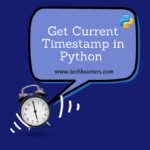Checking whether a Python list is empty is a fundamental task in programming. An empty list often signals the absence of data or the need for specific handling. In this tutorial, we will explore various methods to check if a Python list is empty, covering different aspects and providing multiple examples. Understanding these techniques is crucial for writing robust and error-free Python code.
Check If the Python List is Empty or Not
Before we delve into methods to check for an empty list, let’s briefly revisit the basics of Python lists. A list is an ordered, mutable collection that allows you to store elements of different data types. Lists are defined using square brackets [], and they support various operations like indexing, slicing, and appending.
# Example List
my_list = [1, 2, 3, 'apple', 'orange', True]1. Using if not my_list
The most straightforward and Pythonic way to check if a list is empty is by using an if statement in conjunction with the not keyword.
# Example 1: Using if not statement
if not my_list:
print("The list is empty")
else:
print("The list is not empty")Supplement Info: Pythonic Coding
- Pythonic Approach: The
if not my_listconstruct is considered the most Pythonic way to check for an empty list. It is concise, readable, and widely adopted in the Python community. - Readability Matters: Clarity in code is paramount. Using Pythonic constructs enhances readability, making your code more accessible to others and your future self.
2. Using len()
The len() function returns the number of elements in a list. An empty list will have a length of 0.
# Example 2: Using len() function
if len(my_list) == 0:
print("The list is empty")
else:
print("The list is not empty")Supplement Info: Length vs. Emptiness
- Length for Non-Empty Lists: While using
len()is a valid method, it is generally more efficient to useif not my_listfor checking emptiness, especially when dealing with large lists. This avoids calculating the length.
3. Using == []
Comparing the list to an empty list directly is another way to check for emptiness.
# Example 3: Comparing to an empty list
if my_list == []:
print("The list is empty")
else:
print("The list is not empty")Supplement Info: Direct Comparison
- Comparing to an Empty List: While syntactically correct, this method is less Pythonic compared to
if not my_list. It is less readable and less commonly used.
4. Using all()
The all() function can be used to check if all elements in the list are evaluated to False, including an empty list.
# Example 4: Using all() function
if all(not x for x in my_list):
print("The list is empty")
else:
print("The list is not empty")Supplement Info: Versatility of all()
- Useful for Specific Conditions: The
all()function can be versatile when you want to check if all elements satisfy a specific condition, not just for checking emptiness.
5. Using Exception Handling
Another approach is to use exception handling to catch the case when the list is empty.
# Example 5: Using exception handling
try:
first_element = my_list[0]
print("The list is not empty")
except IndexError:
print("The list is empty")Supplement Info: Exception Handling Considerations
- Performance Implications: Exception handling introduces a performance overhead, so it is generally advisable to use direct checks for emptiness unless there are other reasons to use exception handling.
6. Using bool()
The bool() function can be applied directly to the list to obtain its boolean value.
# Example 6: Using bool() function
if bool(my_list):
print("The list is not empty")
else:
print("The list is empty")Supplement Info: Simplicity of bool()
- Straightforward Approach: While less commonly used, the
bool()function provides a direct and explicit way to check the boolean value of a list.
7. Using Counting
You can count occurrences of a specific element in the list to determine emptiness.
# Example 7: Using counting
if my_list.count('some_element') == 0:
print("The list is empty")
else:
print("The list is not empty")Supplement Info: Element-Specific Checking
- Applicable for Specific Elements: This method is useful when you want to check for the presence or absence of a specific element in the list.
Choosing the Right Method
Choosing the right method to check for an empty list depends on the context and your specific requirements. Here are some considerations:
1. Pythonic Coding
- Prioritize Pythonic constructs like
if not my_listfor clarity and readability.
2. Performance
- Directly checking for emptiness (
if not my_list) is generally more efficient than usinglen().
3. Specific Conditions
- If you have specific conditions for emptiness (e.g., all elements meeting a certain criterion), consider using
all().
4. Element-Specific Checks
- If you’re interested in the presence or absence of specific elements, methods like counting or exception handling may be appropriate.
Supplemental Tips
Tip#1: Default Values with or Operator
You can use the or operator to provide a default value if the list is empty.
# Example: Using a default value with or
my_list = []
result = my_list or ['Default Value']
print(result)
# Output: ['Default Value']This technique is useful when you want to use a default list in case the original list is empty.
Tip#2: Avoiding Mutable Default Arguments
When working with functions that accept lists as arguments, be cautious with mutable default arguments. Using mutable default arguments like an empty list can lead to unexpected behavior.
# Example: Mutable default argument
def process_list(my_list=[]):
# Some operations
return my_list
result1 = process_list()
result2 = process_list()
print(result1)
# Output: []
print(result2)
# Output: []Instead, use None as the default value and create a new list inside the function if needed.
# Example: Using None as default and creating a new list
def process_list(my_list=None):
if my_list is None:
my_list = []
# Some operations
return my_list
result1 = process_list()
result2 = process_list()
print(result1)
# Output: []
print(result2)
# Output: []Tip#3: Consistency in Codebase
Maintain consistency in your codebase by choosing a specific method
for checking emptiness and sticking to it. Consistency improves code readability and reduces the likelihood of errors.
Conclusion
In this comprehensive guide, we explored various methods to check if a Python list is empty. Whether you prioritize Pythonic constructs, performance, or handling specific conditions, understanding the diverse techniques discussed here will empower you to write clear, efficient, and robust Python code.
Choose the method that aligns with your coding style and specific requirements. A solid understanding of list emptiness is a valuable asset for any Python programmer, ensuring that you can handle empty lists gracefully and make your code more resilient.
Happy coding!









